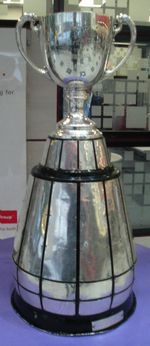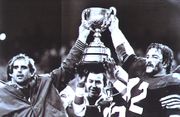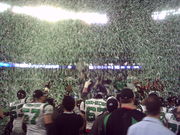Grey Cup
| Grey Cup Coupe Grey |
|
|---|---|
 |
|
| Awarded for | the champions of the Canadian Football League |
| Presented by | Canadian Football League |
| Location | Grey Cup (rotates cities) |
| Country | Canada |
| First awarded | 1909 |
| Currently held by | Montreal Alouettes |
| Official website | CFL.ca |



The Grey Cup (in French: La Coupe Grey) is both the name of the championship of the Canadian Football League (CFL) and the name of the trophy awarded to the victorious team. It is Canada's largest annual sports and television event, regularly drawing a Canadian viewing audience of about 3 to 4 million individuals.[1][2]
Like the Stanley Cup used in the National Hockey League, the Grey Cup is reused every year. This varies from other professional sports leagues, which make a new (but identical) trophy every season for the new champion. Similarly, the Grey Cup also has the name of the winning players, coaches, and management staff (President & General Manager) engraved on its chalice.
Contents |
History
In 1909, the Grey Cup was donated by the then Governor General of Canada, the Earl Grey, to recognize the top amateur rugby football team in Canada. By this time, Canadian football had become markedly different from the rugby football from which it developed. Over time, the Grey Cup became the property of the Canadian Football League as it evolved into a professional football league. Amateur teams ceased competing for the Cup by 1954; since 1965, the top amateur teams, playing in Canadian Interuniversity Sport (CIS), have competed for the Vanier Cup.
The Grey Cup has long served as an unofficial Canadian fall festival generating a large amount of national media coverage, celebration and fan interest across Canada. Many fans travel from across the country to partake in the week of festivities that lead up to the game. Historians date the carnival-like activities associated with the game back to 1948, when fans of the western champion Calgary Stampeders dressed in western gear, square danced, flipped flapjacks, partied in the streets of Toronto and rode a horse through the lobby of the posh Royal York Hotel.
With the addition of American-based teams beginning in 1993, the possibility of the Grey Cup being hoisted by a team south of the 49th Parallel loomed large. In 1994, the Baltimore Stallions (as they were referred to then because of an injunction issued on the behalf of the NFL to prevent this team from using the Colts name) played in the Grey Cup in Vancouver against the home B.C. Lions. A late fumble on the goal line by Baltimore quarterback Tracy Ham gave the B.C. Lions a chance and Lui Passaglia connected on a game-winning FG as time expired, driving the sellout crowd at BC Place into a nationalist frenzy. This patriotic nationalism would be tested further in 1995 when the Baltimore Stallions returned to the Grey Cup against the favoured Calgary Stampeders led by Doug Flutie. Baltimore won the game 37-20 and took the Grey Cup south for a bittersweet parade as Art Modell, owner of the NFL Cleveland Browns, announced his move to Baltimore for the 1996 season only one week before the Grey Cup. After the 1995 season, American-based teams, many of whom were running into financial problems, folded. Only the Baltimore franchise remained and it relocated to Montreal.
The Grey Cup has been broken several times. The trophy was broken in 1978 when Tom Wilkinson and Danny Kepley dropped it, and in 1987 when a celebrating Edmonton Eskimos player sat on it. It was again broken in 1993 when it was head-butted by Edmonton's Blake Dermott. During the victory celebration immediately following the 94th Grey Cup game in 2006, the winning BC Lions accidentally broke the cup from its base, which contains the engraved names of the players on each year's winning team. It was repaired the following Monday.[3] Other notable events include a 1947 fire which almost destroyed the trophy and a 1969 theft in which the trophy was held for ransom. A replica cup was made in 2008.[4]
In November 2006, the CFL confirmed that they were entertaining offers from corporate partners for the naming rights of the Grey Cup.[5] Though the naming rights would apply to the Grey Cup championship game and not the trophy itself, many objected to the idea, claiming that the league should not compromise a national historic treasure for short-term profit.[6]
Engravings
From 1909 to 1916, and from 1920 until 1987, only the winning team and year was engraved on the Grey Cup. Somehow the 1908 Canadian Rugby Football Champions Hamilton Tigers ended up on the Grey Cup, but the cup was first awarded in 1909. (The 1908 Tigers team was later removed). After the 1987 season, the Grey Cup was redone. Team members' names were added to the Grey Cup for each winning team dating back to 1909, with room added for 20 more winning teams. The last space was filled by the Saskatchewan Roughriders in 2007. Starting in 2008, new plates will be added the base of the cup each year, until after 100th Grey Cup in 2012. No decision has been made on how the cup will look after 2013.
Each Grey Cup winning team has the year and team name listed first. This is followed by the President, General Manager and Head Coach. Every player from winning team, who was dressed in the Grey Cup Final, is listed last in alphabetical order. Any player who was not dressed in the Grey Cup game, has been omitted from being listed on the Grey Cup. This includes any player who missed the Grey Cup Final due to injuries. Some injured players were All-Stars that season or nominated or won Individual Awards. However, there has been no deviation from the rule. All other non-playing members are also left off the Grey Cup. Winning teams still award Grey Cup rings to all winning members even if their name does not appear on the Grey Cup. In 2006, the Toronto Argonauts asked to have the names of late Co-owner-Actor John Candy, and Co-Owner-hockey great Wayne Gretzky added to the 1991 Toronto Argonauts Grey Cup team. The CFL said yes, but it is not common practice by the CFL to add missing names years after being engraved.[7]
Broadcasting
First broadcast on the CBC in 1952, for many years the Grey Cup has been the largest television event in Canada, regularly drawing a combined Canadian viewing audience in excess of 4 million on the CBC (over-the-air, in English) and RDS (cable, in French).[1] Starting in 2008, cable network TSN will be the exclusive provider of the Grey Cup for English viewers while RDS will remain the provider for the French broadcast.
From 1962 through 1986, CBC and CTV simulcast the Grey Cup. In 1962, 1965, 1967, 1968 and 1970, CTV commentators were used for the dual network telecast, while in 1963, 1964, 1966 and 1969, CBC announcers were provided. From 1971 through 1986, one network's crew called the first half while the other called the rest of the game. After the 1986 season, CTV dropped their coverage of the CFL and the Grey Cup. From 1987 through 1990, the CFL operated its own syndicated network, CFN. CFN had completely separate coverage of the Grey Cup, utilizing its own production and commentators.
In the United States, the 1992 and 1993 games were on SportsChannel America, while ESPN2 televised the game from 1994 to 1997. The current broadcaster of the Grey Cup is the America One television network, and its affiliates including SportsNet New York, Comcast SportsNet and NESN.[8] American sports network Versus carried the 2008 game. ESPN, which owns 20% of TSN, carried the 2009 game on its ESPN360 broadband service.
The CFL is airing select games on the NFL network.
Festivities
The Grey Cup game is the centre of a larger week of festivities put on by the host cities, including concerts, gala events, and autograph sessions. Also an important part of the event in the halftime show which in recent years has included major Canadian and international musical acts.
Champions
Halftime performances
| Grey Cup | Season | Musical Act(s) |
|---|---|---|
| 79th Grey Cup | 1991 | Luba, Salute To 1992 Winter Olympics Athletes |
| 80th Grey Cup | 1992 | Dan Hill |
| 81st Grey Cup | 1993 | Miss Molly |
| 82nd Grey Cup | 1994 | Tom Cochrane |
| 83rd Grey Cup | 1995 | Jack Semple |
| 84th Grey Cup | 1996 | The Nylons |
| 85th Grey Cup | 1997 | Trooper |
| 86th Grey Cup | 1998 | Love Inc. |
| 87th Grey Cup | 1999 | Parablegics |
| 88th Grey Cup | 2000 | The Guess Who |
| 89th Grey Cup | 2001 | Sass Jordan and Michel Pagliaro |
| 90th Grey Cup | 2002 | Shania Twain |
| 91st Grey Cup | 2003 | Bryan Adams and Sam Roberts |
| 92nd Grey Cup | 2004 | The Tragically Hip |
| 93rd Grey Cup | 2005 | Black Eyed Peas |
| 94th Grey Cup | 2006 | Nelly Furtado feat. Saukrates |
| 95th Grey Cup | 2007 | Lenny Kravitz |
| 96th Grey Cup | 2008 | Theory of a Deadman, Suzie McNeil, and Andrée Watters |
| 97th Grey Cup | 2009 | Blue Rodeo |
See also
- Grey Cup Most Valuable Player
- Grey Cup Most Valuable Canadian
- List of Canadian Football League seasons
- List of awards presented by the Governor General of Canada
- List of awards named after Governors General of Canada
- Grey Cup champions
References
- ↑ 1.0 1.1 Houston, William (December 20, 2006). "Cup moves to TSN in new deal". The Globe and Mail. http://www.theglobeandmail.com/servlet/story/RTGAM.20061220.wsptcfl20/TPStory/Sports/columnists. Retrieved 2007-06-07.
- ↑ William Houston (2006-11-20). "Minor rise in Grey Cup ratings good for CBC". The Globe and Mail. http://www.globesports.com/servlet/story/RTGAM.20061120.wspttruth20/GSStory/GlobeSportsFootball/home. Retrieved 2006-12-03.
- ↑ CBC News (November 20, 2006). "Welder didn't fumble chance at Grey Cup". Canadian Broadcasting Corporation. http://www.cbc.ca/canada/manitoba/story/2006/11/20/cup-fixed.html. Retrieved 2007-06-07.
- ↑ Watts, Richard (2008-08-02). "Engraver fashions copy of Cup". Times Colonist. http://www.canada.com/victoriatimescolonist/news/story.html?id=0a581c25-84b7-4b39-a931-d6147f47273f. Retrieved 2008-10-29.
- ↑ Paraskevas, Joe (November 16, 2006). "CFL may sell naming rights to Grey Cup". CanWest News Service. http://www.canada.com/vancouversun/news/story.html?id=901d1bcd-05c6-43f8-940e-a0da58baf1b6. Retrieved 2007-06-07.
- ↑ Cox, Damien (March 29, 2007). "CFL anoints new commish". Toronto Star. http://www.thestar.com/Sports/article/197256. Retrieved 2007-06-07.
- ↑ Canadian Football League Hall of Fame
- ↑ "CFL.ca Network :: Official site of the Canadian Football League". http://www.cfl.ca/index.php?module=page&id=314. Retrieved 2007-11-13.
External links
- Grey Cup Web Site
- Toronto’s Checkered Grey Cup Past
- CBC Digital Archives – Grey Cup: The Fans and the Fanfare
|
||||||||
|
||||||||||||||||||||||||||||||||||||||||||||